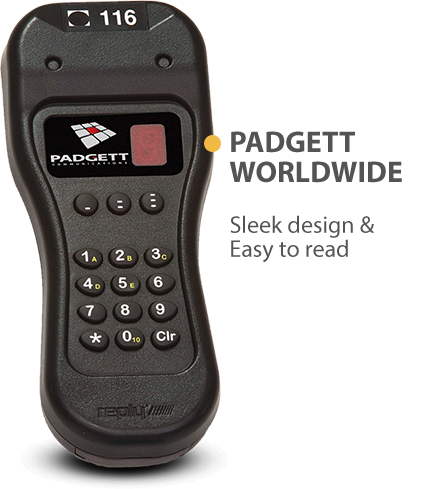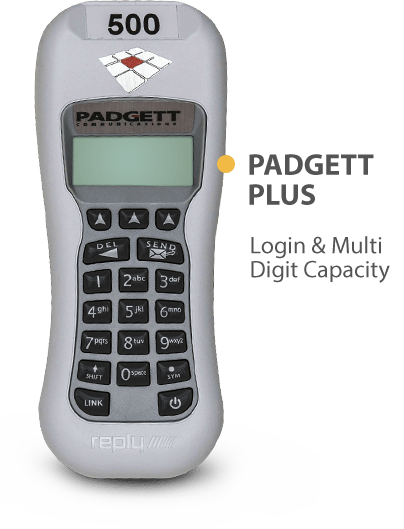What Are Audience Response Systems?
An audience response system (ARS) is a tool that combines wireless hardware and presentation software to increase interaction between a speaker and an audience. Also known as real-time response systems or audience-response meters, an ARS can take many different forms. Our audience response systems use small handheld keypads, often called clickers, that let audience members respond and engage with a presentation by simply pressing a button.
Generally, questions posed through ARS take the form of true/false, multiple choice, or may even call for particular numerical answers. Some systems also feature free-text responses, which are then collected into word clouds for quick evaluation of the most prominent response ideas.
How Do Audience Response Systems Work?
Typically, the presenter uses a computer and a video projector that audience members can easily see. Presentation slides display questions to which audience members respond by pressing a key on their individual handheld device. Answers are sent to a base station, or receiver, attached to the presenter’s computer. The ARS software collects the results, which the presenter may display graphically during the event.
It’s important to note that ARS allows data to be collected anonymously. In addition to taking the fear out replying to questions, this feature is especially useful for events that require voting. ARS can also trace responses to audience members or event participants in situations where tracking is required – classrooms or corporate training events, for example. If necessary, incoming data can be stored in a database on the host computer, and data reports can be generated after an event for further analysis.
Learn more about about audience response systems.
Benefits of Audience Response Systems
Audience response systems are used for a wide variety of applications, from corporate meetings and sales conferences to higher education and television entertainment. In most cases, the purpose is for a presenter or speaker to receive immediate feedback that can be displayed or recorded. But the benefits of ARS extend far beyond this, as the systems can be effectively used to:
- Improve attentiveness – A 2005 University of Wisconsin survey of instructors and students found that the vast majority of participants who used ARS keypads reported increased engagement in the classroom. ARS best stimulates learning when instructors present course material through surveys, pre-tests, and reviews, or when questions are challenging or thought-provoking. (Incidentally, some college professors use ARS to take attendance or grade answers in large lecture halls, which would otherwise be time-consuming and can be potentially unreliable if only relying on mobile survey apps.)
- Collect data – Companies worldwide use audience response systems for product evaluations and strategy sessions in order to gather information that can guide their decisions.
- Poll anonymously – Both large and small organizations frequently rely on ARS for election events, such as appointing new board directors and committee members, or proposing changes to policies, procedures, and bylaws. Essentially, ARS software collects the votes and lists the percentage of respondents who chose a particular candidate but not how individual respondents voted.
- Encourage audience interaction – ARS keypads are novel devices, so the novelty itself can create interesting learning environments. Having been asked about their opinions, people tend to be keenly interested in seeing how their responses compare the responses of fellow audience members.
- Increase communication – Unlike the traditional settings in which audience members must raise their hands and be chosen to respond, ARS provides everyone with an equal opportunity to engage. The presenter can then use their responses to generate meaningful discussion. Given that the system permits anonymous responses, it’s particularly effective for sensitive questions on ethical, legal, and moral issues.
- Confirm audience understanding – ARS can tell you if listeners are struggling with a topic and allows you to modify your presentation or lecture on the fly. In the University of Wisconsin ARS study, faculty members cited this convenience as a key benefit, either agreeing or strongly agreeing with the statement “Clickers allowed me to assess student knowledge on a particular concept.” (Students also recognized this benefit for their own self-assessment, with 75% of them agreeing or strongly agreeing with the claim, “Clickers helped me get instant feedback on what I knew and didn’t know.”)
Technological Advancements
Over time, ARS technology has evolved, moving away from hardware that requires extensive wiring towards handheld wireless devices and small, portable receivers. With the advent of smartphones, there are now systems for which audience members download an app that then communicates with the ARS, which is itself just software running on someone’s device, whether desktop, laptop, tablet, or phone. In this model, the entire ARS is a software product. The hardware is what users bring with them. Currently, however, most audience response systems use wireless hardware, with two primary ways of transmitting data from ARS keypads to the base stations: infrared (IR) and radio frequency (RF). Why? Because mobile apps can fail due to poor Wi-Fi connectivity issues, distraction by the user and weak cell signal. This is why despite the invention of these mobile apps, most advanced presenters still lean on wireless, handheld audience response devices.
Radio Frequency Transmission for ARS
RF transmission makes for a more versatile system that’s ideal for large group environments. RF systems can accommodate hundreds of participants on a single base station. RF systems can also receive signals from all directions and do not require a direct line of sight between the remotes, or handheld devices, and the receiver. Remote devices for RF systems can be more than 300 feet away from the receiver and still accept signals.
By contrast, IR systems are limited to receiving signals from a 280-degree arc across the front and sides of the receiver, and usually remotes must be no more than 50 feet away from the receiver. Consequently, IR systems are better suited for smaller rooms.
An RF system can handle audiences that number in thousands because it allows you to link multiple base stations. In fact, some advanced systems allow over a thousand participants on just one base.
Beyond the Basics
Although ARS with audience keypads have become easier to set up and manage, having a qualified technician on hand is invaluable. When unexpected complications arise, a knowledgeable and experienced ARS technician can test and troubleshoot equipment and save you inordinate amounts of time and stress. As advanced as ARS has become, the system is about much more than hardware and software. It’s about effectively engaging audience members, and you can trust Padgett Communications to help you achieve that. At Padgett, unlike our competitors, we rely on full-time project managers to implement our ARS at events, conferences, and meetings.
By overseeing equipment installation, software programming, and showing you all our ARS features available, our team will give you confidence that you are using our tool to its fullest potential. We even conduct pre-event rehearsals and can facilitate question-answer sessions at the end of your presentation.
As a full-service ARS provider of choice for several Fortune 500 companies, including Microsoft and Walt Disney World, we use state-of-the-art handheld response keypads that operate on secure radio frequencies and have been field-tested to be suitable for virtually any application, even television talk shows. It’s why Oprah, CNN’s Anderson Cooper, Dr. Phil, and others, have relied on Padgett over the years. If you want more information about our audience response systems and the comprehensive service model that set us apart, why not contact us today?




























